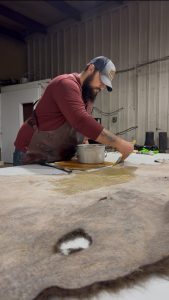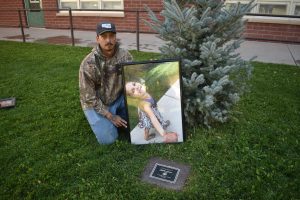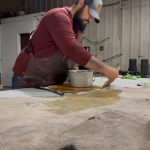Healing the land: Fires reshape big game habitat ahead of hunting season

Rio Blanco Sheriff’s Office/Courtesy photo
As Colorado hunters take to the mountains for archery season, officials with Colorado Parks and Wildlife are assessing how recent wildfires have reshaped big game habitat in Northwest Colorado. Two wildfires, the Lee and Elk, burned across critical elk and mule deer ranges in August, creating immediate challenges for wildlife and access while also offering opportunities for long-term rehabilitation.
Colorado Parks and Wildlife staff were among the first responders when the fires ignited.
“When the Elk Fire was getting going, a couple of us supported the sheriff’s department,” said CPW game warden Tom Knowles, who covers the area. “We helped with pre-evacuation notices and evacuation notices and got everybody in the surrounding areas out of the path at the time. We were just basically another arm of the sheriff’s department helping where we could until incident command took over.”
Different fires, different ranges
The two fires burned very different landscapes in regard to big game habitat.
“The Elk Fire was in a more transitional and winter range for elk and mule deer,” said Mike Swaro, CPW assistant area wildlife manager. “It mainly affected Oak Ridge State Wildlife Area, and a majority of the fire burned right through that core. The south side burned hot and took off a lot, while the north side was patchier, burning in oak brush that can actually create some really good habitat long term.”
Swaro said fire resets plant communities by knocking back successional stages. While the immediate result can be loss of forage, regrowth often provides valuable browse and grass in the years that follow.
The Lee Fire, in contrast, burned traditional winter range.
“That area holds some resident elk and deer, but a lot migrate from the upper White River into that pinyon, juniper and sage country,” Swaro said. “That’s the core of Unit 22, which is Tom’s country.”
Knowles estimated about one-fifth of Unit 22 was burned.
“While it is a huge fire, there’s still a lot of country left in that winter range,” he said. “When the animals do come off the summer range, it’s a mystery how the dispersal is going to be. That’s just going to be a wait-and-see.”
How elk and deer respond to burn scars
“Elk will utilize burn scars pretty quick,” Swaro said. “We could even have some elk use these areas this fall, especially if we get rain and green-up. Being grazers, once a grass component gets established, they’ll move into those areas within the first few years.”
Mule deer, however, may take longer to return.
“Deer are more of a browser species that hit sagebrush, mahogany, serviceberry and shrubs,” Swaro explained. “That browse won’t be as available in fall and winter, so their use of those areas will depend a lot on moisture and regrowth over the next few years.”
Knowles also explained that wildlife migration often happens regardless of habitat projects designed to slow it.
“Based on collar data, when they decide to migrate, they just move and get to where they’re going,” he said. “Some of this fire burned really hot, which can sterilize soil, so it takes longer to respond. Other parts will come back really well. Fire is a great habitat tool — though not always at this scale.”
Swaro added that deer and elk migration patterns differ.
“Deer are hard-set on their time frame. By the end of October, they’re on the move to winter range, with or without winter conditions,” he said. “They have strong fidelity to the same areas year after year. Elk usually take a lot of snow to push them out, so they’ll respond differently than deer.”
Impacts on hunters
The fires have also affected CPW’s approach to licenses, as some hunters have been offered the opportunity to return tags for refunds and have their preference points restored.
“Safety factors are paramount,” Swaro said regarding this year’s hunting seasons. “If areas are still closed due to hot spots or flooding, that reduces the unit’s availability. That’s when we offer opportunities for people to get their money and points back.”
Knowles added that overcrowding is another concern moving forward.
“When you have a large chunk of a unit displaced, hunters get pushed into smaller areas,” he said. “Some people spend a lot of points or money on a license and they don’t want that sort of hunting experience.”
Looking ahead, Swaro noted that habitat loss could influence tag allocations in subsequent seasons.
“When you lose that amount of habitat in the short term, those animals have to go somewhere else,” Swaro said. “That affects overall herd pressure. In the long term, though, it can be a giant benefit for habitat. We already have seed mixes ready to go in before snowfall so we’ll get good germination next spring.”
Knowles said the location of the burn matters.
“Winter range is your limiting factor on how many animals a habitat can support,” he said. “Whenever you have a fire in winter range, that affects things more. We don’t know how fast the habitat will respond, and that’ll determine licensing decisions moving forward.”
Rehabilitation and hunter responsibility
Revegetation is already in the planning stages, with CPW preparing seed mixes that include shrubs critical for mule deer forage such as sagebrush, mahogany and bitterbrush.
Swaro reminded hunters to be aware of ongoing risks beyond the fire itself.
“Be cognizant of flash flooding and closures. If a road is closed, there’s a reason for it,” he said. “Also, some fences or boundaries may be gone, but hunters still need to respect those areas and not drive into spots they couldn’t before.”
Knowles agreed.
“Since there isn’t vegetation and some trees are skeletons, if people drive on it now, it becomes a road,” he said. “Respect the ground and remember you’re out here to enjoy it. Ranchers are trying to get it back in shape, and we need to give the land time to heal.”
A season of uncertainty
For now, CPW officials say hunters should be prepared for uncertain conditions and limited access as the season opens. Animal dispersal patterns may change, habitat will vary depending on fire severity and some areas could remain closed under federal orders into the fall.
“Fire has two sides of the sword,” Swaro said. “In the short term it hurts, but in the long term it can be really good for habitat.”
As archery season commences, and with muzzleloading and rifle seasons on the horizon, that balance between loss and renewal will play out in real time across the landscapes of Northwest Colorado.

Support Local Journalism

Support Local Journalism
Readers around Craig and Moffat County make the Craig Press’ work possible. Your financial contribution supports our efforts to deliver quality, locally relevant journalism.
Now more than ever, your support is critical to help us keep our community informed about the evolving coronavirus pandemic and the impact it is having locally. Every contribution, however large or small, will make a difference.
Each donation will be used exclusively for the development and creation of increased news coverage.






